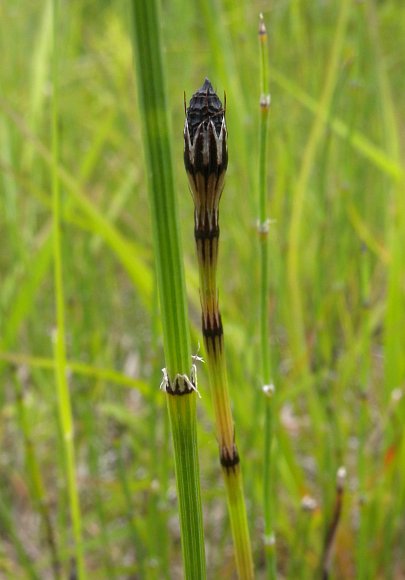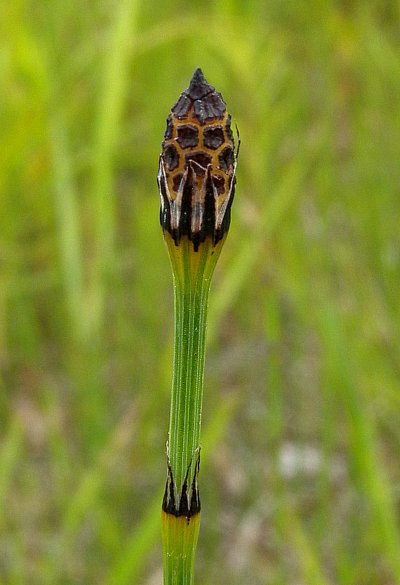
The sheath teeth are narrowly triangular with conspicuous white-membranous margins, otherwise they are predominately black. The tips of these teeth are often bristly (aristate), otherwise they are narrowly acute. The stems of fertile shoots terminate in solitary cones about 5-8 mm. long. These cones are ovoid-ellipsoid in shape, sessile to short-stalked, and they have small pointed tips. Several rows of angular flat-topped sporophores occur around the circumference of each cone. Depending on the maturity of the cone, the sporophores vary in color from light brown to black, while the cone itself varies from green to brown. Several sporangia (spore-bearing structures) are located along the circumference of each sporophore. These sporangia eventually split open to release green spores that are distributed by the wind. The root system is long-rhizomatous and fibrous; the rhizomes are usually black. Clonal colonies of plants often develop from the rhizomes.
Cultivation: The preference is full sunlight, wet to moist conditions, and sandy soil with some organic material. At favorable sites, this plant can spread aggressively by means of its rhizomes. It is very winter-hardy.

Range & Habitat: The native Variegated Horsetail occurs in the northern half of Illinois, where it is usually rare (see Distribution Map). It more common in areas that lie north of the state. This horsetail has a wide distribution in boreal, and even arctic, areas of North America. It also occurs in some parts of northern Eurasia. Habitats include bogs, fens, low areas along ponds, low areas along stagnant to slow-moving rivers, sandy interdunal swales, moist sand flats, moist areas of middle to upper beaches along Lake Michigan, powerline clearances over moist sandy areas, and sandy ditches. In Illinois, Variegated Horsetail is usually found in high quality natural areas. It is rarely cultivated.
Faunal Associations: Various insects are known to feed on horsetails (Equisetum spp.) in North America; these insects often have a boreal distribution, where horsetails are more common. Examples include stem-inhabiting larvae of the Horsetail Weevil (Grypus equiseti), stem-eating larvae of sawflies (Dolerus apricus, Dolerus tibialis conjugatus), an aphid that feeds on roots (Anoecia equiseti), and a leaf beetle (Hippuriphila canadensis); see Harms & Grodowitz (2009), Smith (2006), Blackman & Eastop (2013), and Clark et al. (2004). There are also records of vertebrate animals feeding on horsetails. In boreal and arctic regions, the Snow Goose and Caribou are known to browse on the stems of Variegated Horsetail occasionally; the Moose also browses on these plants (Prevett et al., 1979; Thomas et al., 1996; Martin et al., 1951/1961).

Photographic Location: A powerline clearance at Illinois Beach State Park in NE Illinois, where this horsetail is locally common.
Comments: Variegated Horsetail has a tendency to form rather dense colonies of erect to sprawling plants. It remains green throughout the year. The common name refers to the contrasting colors of the teeth on the sheaths (white and black). These teeth are rather persistent and they often have bristly tips. This horsetail can be distinguished from other horsetails by its smaller size (the stem diameter is only 1.5–4 mm. across), showy teeth of its sheaths, small pointed tips of its cones, and the relatively small central cavity of its stems (about one-third of the stem diameter). On rare occasions, it will hybridize with other horsetails. These hybrids include Equisetum vareigatum × Equisetum hyemale (Equisetum × mackayii) and Equisetum variegatum × Equisetum laevigatum (Equisetum × nelsonii). Another common name of Equisetum variegatum is Variegated Scouring Rush.